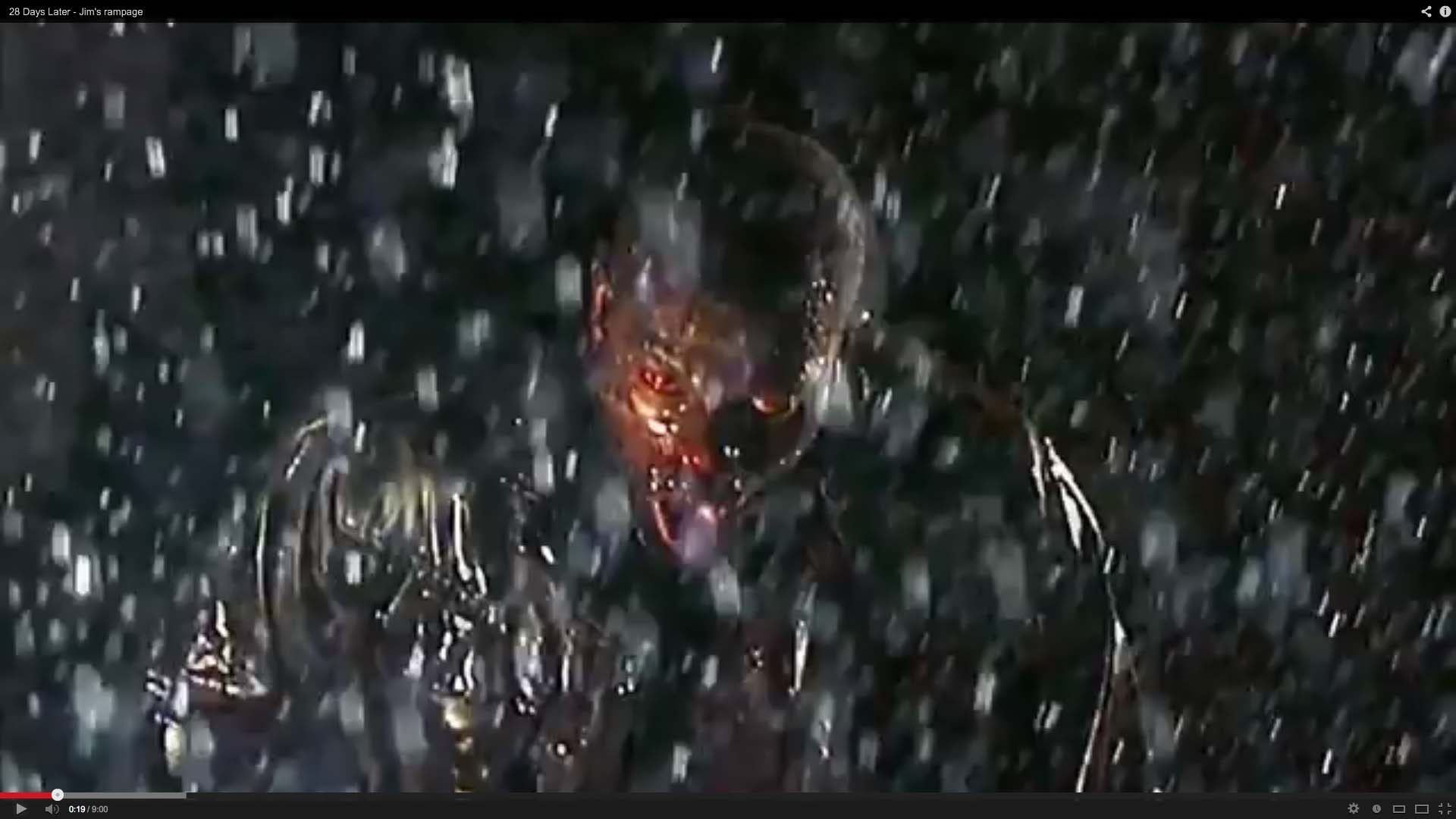

| In the horror genre, one depiction of blood that has gained some momentum in terms of its pervasiveness and use has been the depiction of characters bleeding from their eyes. The most notable example of this depiction of blood is in the film "28 Days Later" and the film's sequel "28 Weeks Later". In both of the films, a deadly virus has been unleashed upon the population of Britain. This virus, the "rage virus", manifests quickly within its victims, is incurable, and causes its victims to lose their mental faculties and to become bloodthirsty and murderous creatures. These creatures are termed by the characters within this film as "the infected". The most notable features of the infected are that they are unwavering in their desire to murder and consume the flesh of the uninfected, they occasionally vomit and spew blood (one of the ways through which an infected may infect someone else with the virus), and that, once infected, their eyes fill with blood and bleed. This part of my analysis on the use of blood in film will focus on the third feature of the infected which I have listed: their bloody eyes. |

|
From a psychoanalytic standpoint, it is notable that one of the main features of the infected is that their eyes fill with blood and bleed once they have been infected. In Carol J. Clover's work "Men, Women, and Chainsaws: Gender in the Modern Horror Film" she discusses the use of depictions of eyes in horror films. In this work, Clover says that the reason behind horror films focusing on eyes is in order to "tease, confuse, block, and threaten the spectators own vision" (Clover, 166) and that this concern with eyes in horror is related to "the way we see ourselves and others and the consequences that often attend our usual manner or perception" (Clover, 167). For the purposes of this analysis, I am mostly concerned with how the use of eyes within horror films is related to the way in which we perceive ourselves.
The relationship between eyes in horror films and the audience's self-perception is also related to the psychoanalytical theories regarding voyeurism and scopophilia. Both of these terms in psychoanalysis are related to the pleasure that one gets from viewing. This pleasure from viewing is further expanded upon in Mulvey's work "Visual Pleasure and Narrative Cinema." In this work, Mulvey discusses how "looking itself is a source of pleasure" (Mulvey, 200) and that along with this pleasure comes identification. Jennifer Tuder also examines the relationship between viewing a performance and desiring to identify with the performer in her work "The Envious Root of Performance: Desiring Other". There are also sexual implications associated with this type of viewing, but these sexual implications are less applicable to the example of blood filled eyes in "28 Days Later". What is pertinent to this project, however, is the identification that comes with viewing.

|
In the film, the point at which a viewer ceases to identify with a character is when they have become infected. The most notable example of this in the film is when the character "Frank"--a substitute father figure for the other characters--is infected by a drop of blood from an infected body that falls from a crow's mouth and lands in Frank's eye. After the drop of blood lands in Frank's eye, he quickly understands what has happened and his transformation into one of the infected begins just as quickly. The finality of Frank's transformation occurs when his now bleeding eyes are revealed to the audience. The revealing of Frank's eyes in this scene is also the point at which audience members no longer desire or are capable of identifying with him; he has turned and become one of "them", no longer a survivor whom viewers may identify with or want to be. |
The blood that is present in Frank's eyes also serves to sever the connections that audience members have with him. In this scene, the blood in Frank's eyes serves two purposes. The first of these is to show the distinction between Frank and the rest of the group, and to inform viewers to now associate him with the othered group of the infected. The blood in Frank's eyes also confronts the audience with blood's connotations with death. In this sense, Frank has not yet actually died, but his death as a human and rebirth as one of the infected has occurred in the perception of the audience. The blood coming from the eyes of the infected also works to confront the audience with the abnormality of this kind of bleeding and to further establish the separation between characters whom we can identify with and characters--more accurately described as figures--whom we cannot. The coupling of the connotation of eyes as "windows to the soul" and blood's connotations with death serves to inform the audience that all that is present within the infected is abnormality and death.
| The film "Event Horizon" similarly depicts characters bleeding from their eyes. In this film, the character "Dr. Weir" is also infected, in a sense. Unlike the viral infection in "28 Days Later", however, Dr. Weir is infected by the evil that is emanating from the spacecraft that he helped to build. Dr. Weir's infection by the evil of the ship comes to fruition in a scene in which he gouges his own eyes out. Up until this point, viewers were able to identify with Dr. Weir. After audiences are shown Weir's self-mutilation, on the other hand, this narcissistic identification is no longer possible because Dr. Weir has now become a corporeal manifestation of the evil of the ship. Similarly to the bloody eyes in "28 Days Later", the blood that comes from Dr. Weir's eyes informs the audience that Dr. Weir's sole motivations now are to inflict harm and destruction. By removing his own eyes, Dr. Weir's character can also be seen as lacking a soul due to the connotations previously expressed between eyes and the soul. |


|
| Blood as Rebirth | Consumption of Blood/ Vampires | Blood Baths | Home |
Clover, Carol J. Men Women and Chainsaws: Gender in the Modern Horror Film. London: BFI, 1992. Print
Mulvey, Laura. Visual Pleasure and Narrative Cinema. N.p.: n.p., 1999. Print.
Tuder, Jennifer L. "The Envious Root Of Performance: Desiring Other." Text & Performance Quarterly 26.1 (2006): 17-24. Communication & Mass Media Complete. Web. 8 May 2013.
"28 Days Later - Jim's Rampage." YouTube. YouTube, 01 June 2012. Web. 08 May 2013.
"28 Days Later Second Best Scene." YouTube. YouTube, 27 May 2009. Web. 08 May 2013.
"Event Horizon - 1997 - "Dr.Weir Goes Mad" |HD|." YouTube. YouTube, 29 July 2012. Web. 08 May 2013.
"Event Horizon (6/9) Movie CLIP - Pure Evil (1997) HD." YouTube. YouTube, 09 Oct. 2011. Web. 08 May 2013.